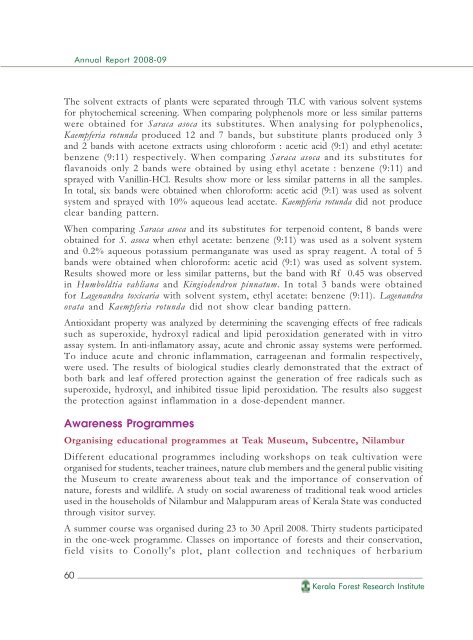2008-'09 - Kerala Forest Research Institute
2008-'09 - Kerala Forest Research Institute
2008-'09 - Kerala Forest Research Institute
You also want an ePaper? Increase the reach of your titles
YUMPU automatically turns print PDFs into web optimized ePapers that Google loves.
Annual Report <strong>2008</strong>-09<br />
The solvent extracts of plants were separated through TLC with various solvent systems<br />
for phytochemical screening. When comparing polyphenols more or less similar patterns<br />
were obtained for Saraca asoca its substitutes. When analysing for polyphenolics,<br />
Kaempferia rotunda produced 12 and 7 bands, but substitute plants produced only 3<br />
and 2 bands with acetone extracts using chloroform : acetic acid (9:1) and ethyl acetate:<br />
benzene (9:11) respectively. When comparing Saraca asoca and its substitutes for<br />
flavanoids only 2 bands were obtained by using ethyl acetate : benzene (9:11) and<br />
sprayed with Vanillin-HCl. Results show more or less similar patterns in all the samples.<br />
In total, six bands were obtained when chloroform: acetic acid (9:1) was used as solvent<br />
system and sprayed with 10% aqueous lead acetate. Kaempferia rotunda did not produce<br />
clear banding pattern.<br />
When comparing Saraca asoca and its substitutes for terpenoid content, 8 bands were<br />
obtained for S. asoca when ethyl acetate: benzene (9:11) was used as a solvent system<br />
and 0.2% aqueous potassium permanganate was used as spray reagent. A total of 5<br />
bands were obtained when chloroform: acetic acid (9:1) was used as solvent system.<br />
Results showed more or less similar patterns, but the band with Rf 0.45 was observed<br />
in Humboldtia vahliana and Kingiodendron pinnatum. In total 3 bands were obtained<br />
for Lagenandra toxicaria with solvent system, ethyl acetate: benzene (9:11). Lagenandra<br />
ovata and Kaempferia rotunda did not show clear banding pattern.<br />
Antioxidant property was analyzed by determining the scavenging effects of free radicals<br />
such as superoxide, hydroxyl radical and lipid peroxidation generated with in vitro<br />
assay system. In anti-inflamatory assay, acute and chronic assay systems were performed.<br />
To induce acute and chronic inflammation, carrageenan and formalin respectively,<br />
were used. The results of biological studies clearly demonstrated that the extract of<br />
both bark and leaf offered protection against the generation of free radicals such as<br />
superoxide, hydroxyl, and inhibited tissue lipid peroxidation. The results also suggest<br />
the protection against inflammation in a dose-dependent manner.<br />
Awareness Programmes<br />
Organising educational programmes at Teak Museum, Subcentre, Nilambur<br />
Different educational programmes including workshops on teak cultivation were<br />
organised for students, teacher trainees, nature club members and the general public visiting<br />
the Museum to create awareness about teak and the importance of conservation of<br />
nature, forests and wildlife. A study on social awareness of traditional teak wood articles<br />
used in the households of Nilambur and Malappuram areas of <strong>Kerala</strong> State was conducted<br />
through visitor survey.<br />
A summer course was organised during 23 to 30 April <strong>2008</strong>. Thirty students participated<br />
in the one-week programme. Classes on importance of forests and their conservation,<br />
field visits to Conolly's plot, plant collection and techniques of herbarium<br />
60<br />
<strong>Kerala</strong> <strong>Forest</strong> <strong>Research</strong> <strong>Institute</strong>

















